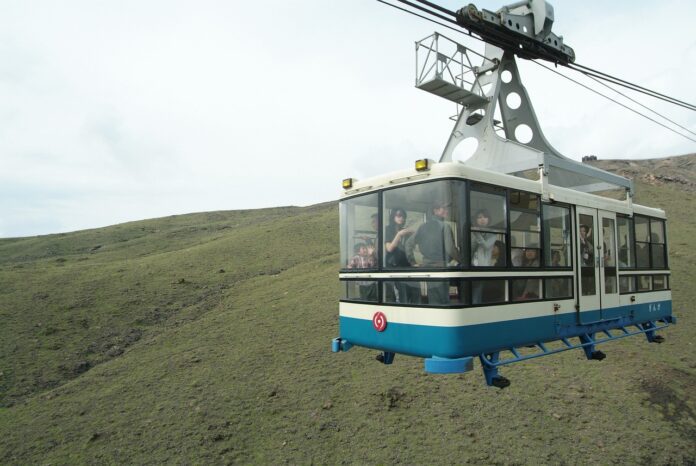Ropeway Transportation in India: A Promising Alternative
Ropeway transportation is emerging as a sustainable and efficient alternative to traditional modes of transportation in India. Here’s a comprehensive overview of its current status and potential:
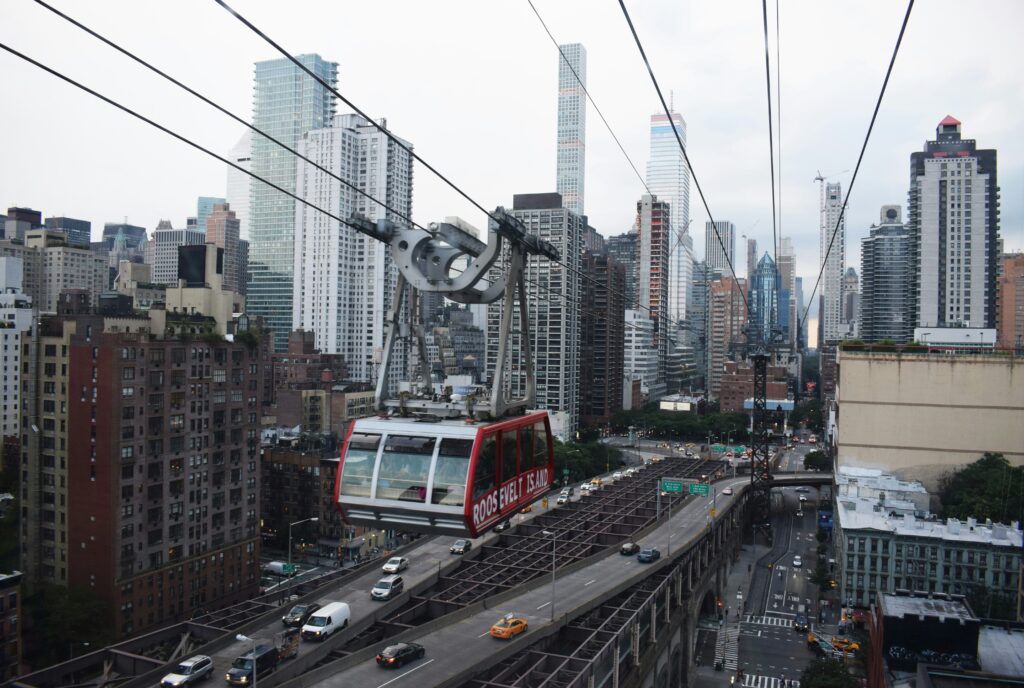
Current Status:
Limited Implementation: As of 2023, India has only a handful of operational ropeway systems, primarily focusing on tourism and pilgrimage sites.
National Ropeways Development Programme: Recognizing the potential of this technology, the government launched the “National Ropeways Development Programme – Parvatmala Pariyojana” in 2022. This initiative aims to develop 800 km of ropeway networks across the country, focusing on urban mobility, last-mile connectivity, and improving accessibility in hilly and challenging terrains.
First Urban Project: The first urban ropeway project under Parvatmala Pariyojana is currently underway in Varanasi. This 3.75 km project aims to ease traffic congestion and provide convenient transportation for tourists and residents.
Public-Private Partnership (PPP) Model: The government encourages private sector participation through the PPP model to accelerate ropeway development.
Potential Benefits:
Sustainable and Eco-friendly: Ropeways require less land acquisition compared to traditional roads, minimizing environmental impact. They also operate using electricity, contributing to emission reduction.
Efficient and Cost-effective: Ropeways can efficiently transport large volumes of passengers over long distances, particularly in mountainous regions where traditional infrastructure development is costly.
Accessibility and Connectivity: Ropeways offer reliable and convenient access to remote areas and difficult terrains, promoting tourism and economic development.
Reduced Traffic Congestion: Ropeways can significantly alleviate traffic congestion in urban areas, leading to improved air quality and public health.
Scenic Experience: Ropeways offer passengers breathtaking panoramic views, enhancing the travel experience.
Challenges and Future Outlook:
Lack of Awareness: Public awareness about ropeway technology and its benefits remains relatively low.
Regulation and Standards: Establishing clear regulations and safety standards for ropeway construction and operation is crucial.
Funding and Investment: Adequate funding and investment are essential for the successful implementation of the National Ropeways Development Programme.
Technology Development: Continued research and development are needed to improve the efficiency and safety of ropeway technology.
Despite these challenges, the future of ropeway transportation in India appears promising. With continued government support, technological advancements, and increased awareness, ropeways have the potential to revolutionize transportation and infrastructure development in India.
What is ropeway transport
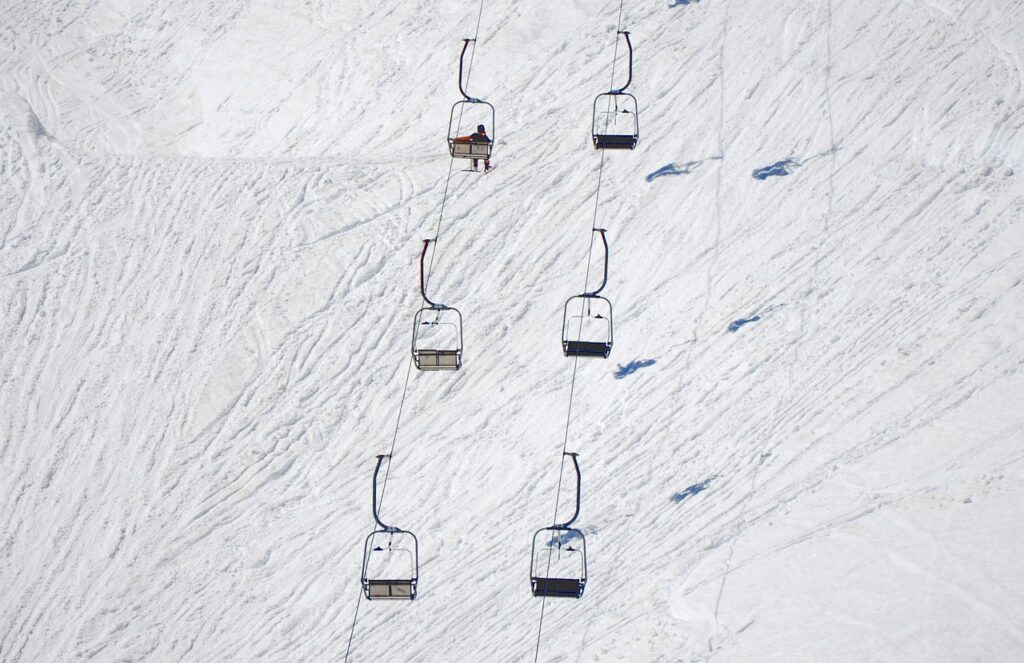
Ropeway transport, also known as cable transport or aerial transportation, is a system that uses cables to transport people and goods over long distances. It’s often used in mountainous regions or difficult terrains where traditional infrastructure development is challenging.
Here’s a breakdown of the key features of ropeway transport:
Types:
- Gondolas: Enclosed cabins suspended from cables, typically used for passenger transport.
- Chairlifts: Open-air chairs attached to cables, commonly used for ski resorts and tourist destinations.
- Aerial tramways: Large cabins that transport passengers and cargo, often used for crossing rivers or valleys.
- Ropeway conveyors: Used for transporting goods over long distances, particularly in mining and construction industries.
Benefits:
- Sustainable and eco-friendly: Less land acquisition and minimal environmental impact compared to traditional roads.
- Efficient and cost-effective: High passenger capacity and ability to cover long distances over difficult terrain.
- Accessibility and connectivity: Provides access to remote areas and improves connectivity in mountainous regions.
- Reduced traffic congestion: Can significantly alleviate traffic issues in urban areas.
- Scenic experience: Offers breathtaking panoramic views for passengers.
Challenges:
- Initial investment: High cost of construction and maintenance compared to traditional roads.
- Weather dependency: Operations can be affected by adverse weather conditions, such as strong winds or heavy snowfall.
- Safety concerns: Robust safety protocols and regular inspections are crucial to ensure safe operation.
- Limited implementation: Currently less widespread compared to traditional transportation options.
Future potential:
With advancements in technology and growing awareness of its benefits, ropeway transport is expected to play a significant role in future infrastructure development. It offers a sustainable and efficient solution for transportation in challenging terrains and urban environments.
Why required ropeway transport
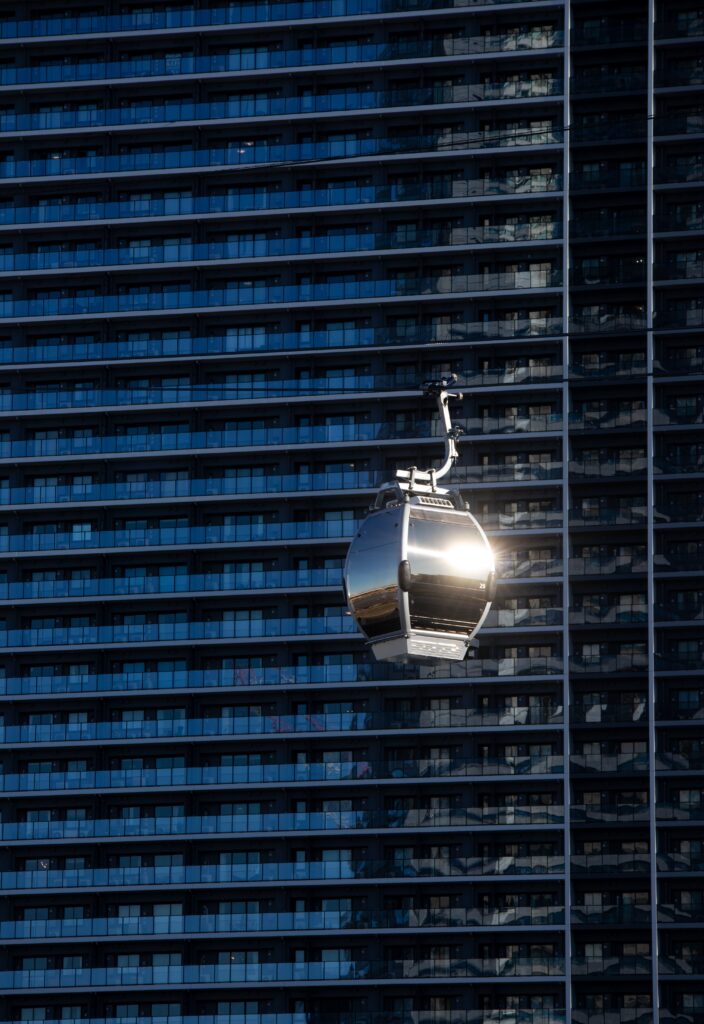
There are several compelling reasons why ropeway transport is becoming increasingly necessary:
1. Addressing Transportation Challenges in Difficult Terrain:
Mountainous regions: Traditional road construction in mountainous areas is often expensive, environmentally damaging, and prone to landslides. Ropeways offer a more sustainable and efficient solution, requiring less land acquisition and adapting to steep slopes.
Urban areas: Traffic congestion in urban areas is a growing problem. Ropeways can provide last-mile connectivity and alleviate traffic congestion, especially in areas with limited space for traditional infrastructure development.
2. Promoting Sustainability and Environmental Protection:
Reduced land use: Ropeways require significantly less land than roads, minimizing deforestation and habitat fragmentation.
Lower emissions: They operate using electricity, contributing to cleaner air and reduced greenhouse gas emissions compared to conventional transportation options.
Minimal noise pollution: Ropeways operate quietly, minimizing noise pollution in urban areas and sensitive ecosystems.
3. Enhancing Accessibility and Economic Development:
Connecting remote areas: Ropeways provide crucial access to remote communities and tourist destinations, fostering economic development and improving the lives of residents.
Boosting tourism: They offer a unique and scenic travel experience, attracting tourists and generating revenue for local communities.
Promoting trade and commerce: Ropeways can facilitate efficient transportation of goods over long distances, supporting trade and commerce in remote regions.
4. Supporting Efficient and Cost-effective Transportation:
High passenger capacity: Ropeways can transport large volumes of passengers efficiently, making them suitable for mass transit applications.
Reduced construction costs: Compared to traditional roads, the construction cost of ropeways can be significantly lower, especially in challenging terrains.
Minimal maintenance needs: Properly constructed and maintained ropeway systems require minimal maintenance, reducing operational costs.
5. Contributing to Sustainable Urban Development:
Smart cities: Ropeways can be integrated into smart city initiatives, promoting sustainable urban development and reducing dependence on private vehicles.
Improved public health: By reducing traffic congestion and air pollution, ropeways can contribute to improved public health in urban areas.
Enhanced livability: Ropeways can create more livable cities with reduced noise pollution and improved air quality.
Overall, ropeway transport offers a promising solution to address various transportation challenges, promote sustainability, and contribute to economic development. As technology advances and awareness grows, ropeways are poised to play a significant role in shaping the future of transportation.
Who Invented ropeway transport
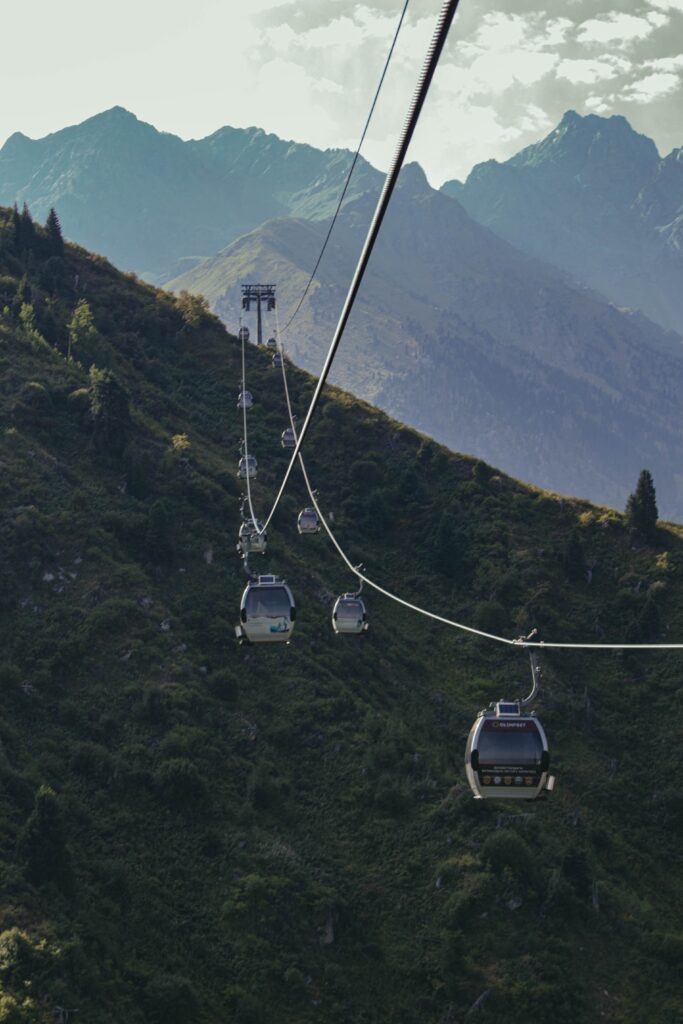
It’s difficult to pinpoint the single inventor of ropeway transport as the concept has evolved over centuries and involved contributions from various individuals and cultures. However, here’s a brief timeline of key developments:
Early Origins:
Ancient China (200 BC): The earliest recorded ropeway system involved simple inclined planes and ropes for transporting goods and materials.
Medieval Europe (10th Century): Aerial ropeways were used in mining and construction, with modifications for passenger transport in some regions.
Modern Developments:
- 18th Century: Adam Wybe introduced the concept of gondolas suspended from cables, paving the way for modern passenger ropeways.
- 19th Century: The invention of the steel cable by Wilhelm Albert improved safety and reliability, leading to wider adoption of ropeway technology.
- 20th Century: Development of various ropeway types, including chairlifts and aerial tramways, further expanded their applications.
Notable Contributors:
- Adolf Bleichert (Germany): Pioneered the construction of long-distance ropeways and developed innovative designs.
- Eugen Loder (Switzerland): Developed the detachable grip system, enabling efficient loading and unloading of passengers.
- Konrad Doppelmayr (Austria): Founded Doppelmayr, a leading manufacturer of ropeway systems worldwide.
Therefore, attributing the invention of ropeway transport to a single individual is inaccurate. It’s a collaborative effort with continuous advancements built upon the innovations of various contributors throughout history.
Ropeways Other Famous names
Aside from the ropeway locations you mentioned, here are some other famous ropeways around the world, often referred to by various names:
Cable Cars:
- San Francisco Cable Cars (San Francisco, USA): Iconic cable cars traversing the hilly streets of San Francisco, a symbol of the city.
- Peak Tram (Hong Kong): Funicular railway taking you to Victoria Peak, offering panoramic views of Hong Kong Island.
- Lombard Street (San Francisco, USA): Crooked street known as “The Crookedest Street in the World,” sometimes referred to as a “cable car street.”
Gondolas:
- Peak 2 Peak Gondola (Whistler Blackcomb, Canada): Longest unsupported span between two suspension bridges, connecting Whistler and Blackcomb mountains.
- Sky Gondola (Queenstown, New Zealand): Offers stunning views of the Remarkables mountain range and Lake Wakatipu.
- Tianzi Mountain Cable Car (Zhangjiajie, China): Taking you to the iconic Tianzi Mountain, known for its pillar-like rock formations.
Aerial Tramways:
- Palm Springs Aerial Tramway (California, USA): Rotating tram ascending to the top of Mount San Jacinto for breathtaking views of the Coachella Valley.
- Roosevelt Island Tramway (New York City, USA): Connecting Roosevelt Island to Manhattan, offering unique views of the city skyline.
- Mi Teleferico (La Paz, Bolivia): Extensive network of aerial tramways connecting various districts in La Paz, known for its colorful cabins and stunning views of the city and the Andes Mountains.
Other Names:
- Funiculars: Inclined railways often used in hilly areas, like the Funicular de Artxanda in Bilbao, Spain.
- Seilbahnen (German): General term for ropeways in German-speaking countries.
- Téléphériques (French): General term for ropeways in French-speaking countries.
Additional Points:
- Many ropeway systems have unique names reflecting local culture or landmarks, like the Ngong Ping 360 in Hong Kong or the Sugarloaf Cable Car in Rio de Janeiro.
- Some ropeways are named after specific brands or companies, like the Doppelmayr Gondola in Whistler Blackcomb.
This list is not exhaustive, and there are many other fascinating ropeways around the world with diverse names and histories.
World Famous Ropeway Transportation Systems
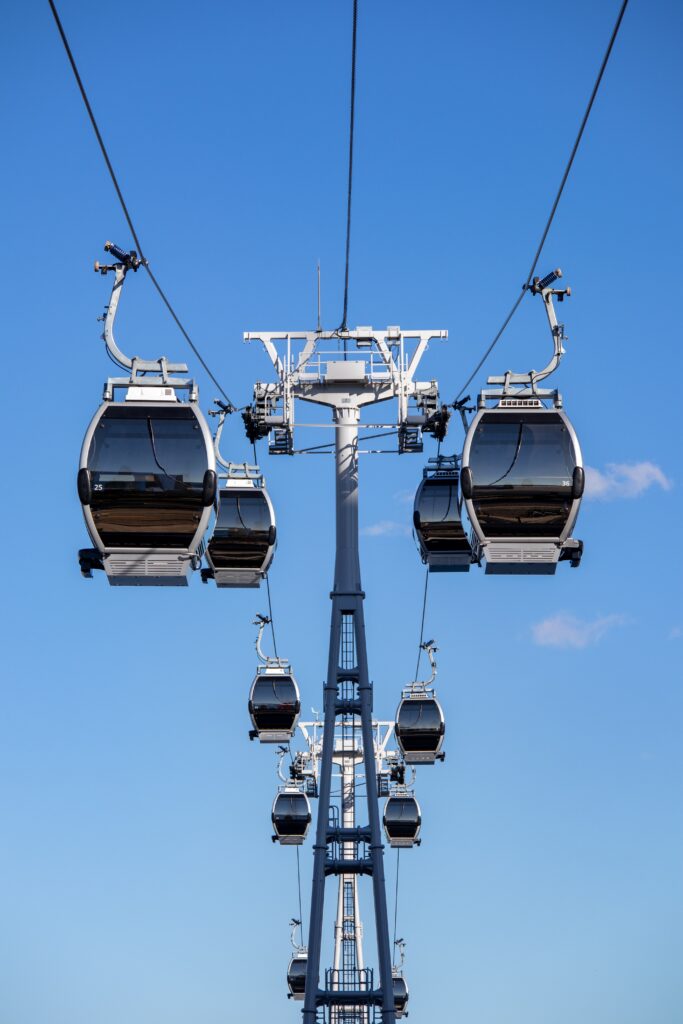
Ropeway transportation, often known as cable cars, gondolas, or aerial tramways, offers breathtaking views and efficient travel in diverse landscapes. Here are some of the most famous ropeway systems around the world:
Europe:
Jungfrau Railway (Switzerland): Climb aboard the highest cogwheel railway in Europe, reaching the Jungfraujoch station at 3,454 meters and enjoying panoramic views of the Swiss Alps.
Titlis Rotair Gondola (Switzerland): Experience the world’s first rotating gondola, offering 360-degree views of the Titlis glacier and surrounding peaks.
Männlichen Gondola (Switzerland): This picturesque gondola takes you to the Männlichen mountain, offering stunning views of the Eiger, Mönch, and Jungfrau peaks.
Mont Blanc Tramway (France, Italy, Switzerland): Ascend to the highest point in Western Europe, the Aiguille du Midi summit, via a series of gondolas and cable cars, offering breathtaking views of Mont Blanc and the surrounding Alps.
North America:
Palm Springs Aerial Tramway (California, USA): This rotating tram takes you from the desert floor to the top of Mount San Jacinto, offering panoramic views of the Coachella Valley and the San Jacinto Mountains.
Roosevelt Island Tramway (New York City, USA): This gondola system connects Roosevelt Island to Manhattan, offering stunning views of the New York skyline and the East River.
Peak 2 Peak Gondola (Whistler Blackcomb, Canada): Experience the world’s longest unsupported span between two suspension bridges in this gondola, connecting Whistler and Blackcomb mountains.
Asia:
Ngong Ping 360 (Hong Kong): This iconic cable car system takes you up to Ngong Ping Village on Lantau Island, offering panoramic views of the South China Sea, Tian Tan Buddha, and the surrounding mountains.
Yushan Ropeway (Taiwan): Ascend to the summit of Mount Yushan, the highest peak in Taiwan, via a series of gondolas, enjoying stunning views of the Yushan National Park.
Genting Skyway (Malaysia): This cable car system takes you to the Genting Highlands resort, offering breathtaking views of the Titiwangsa Mountains and the surrounding rainforests.
Other Notable Ropeway Systems:
Table Mountain Aerial Cableway (South Africa): Ascend to the top of Table Mountain, a UNESCO World Heritage Site, offering panoramic views of Cape Town and the surrounding coastline.
HarbourView Gondola (Wellington, New Zealand): Enjoy stunning views of Wellington city and the harbour from this scenic gondola ride.
Sugarloaf Cable Car (Rio de Janeiro, Brazil): Ascend to the top of Sugarloaf Mountain, offering iconic views of Rio de Janeiro and the Christ the Redeemer statue.
These are just a few examples of the many incredible ropeway systems around the world. Whether you’re seeking breathtaking views, an efficient mode of transportation, or a unique travel experience, ropeway systems offer an unforgettable journey.
Ropeway transport advantages and disadvantages
| Aspect | Pros | Cons |
|---|---|---|
| Efficiency and Capacity | High passenger capacity, efficient transportation over long distances, particularly in challenging terrain | Limited capacity compared to other mass transit options (e.g., subways) |
| Accessibility and Connectivity | Provides access to remote areas, improves connectivity in mountainous regions, and facilitates last-mile connectivity in urban areas | Accessibility can be limited by the availability of stations and lines |
| Sustainability and Environmental Impact | Low land use requirements compared to traditional roads, minimal noise pollution, and potential for reduced emissions depending on energy source | Environmental impact of construction and potential for visual intrusion in sensitive landscapes |
| Cost-Effectiveness | Construction costs can be lower than traditional roads in challenging terrain, and maintenance requirements can be minimal | Initial investment costs can be high |
| Safety | Modern ropeway systems are designed with safety features and undergo regular inspections | Safety concerns can arise from weather conditions, equipment malfunction, or human error |
| Scenic Experience | Offers breathtaking panoramic views for passengers, enhancing the travel experience | Scenic views may not be relevant for all users and may not outweigh other considerations |
| Economic Development | Promotes tourism, supports trade and commerce in remote regions, and creates new job opportunities | Economic benefits may not be immediate or widespread |
| Urban Development | Can contribute to smart city initiatives, improve public health by reducing traffic congestion and air pollution, and create more livable cities | Integration with existing infrastructure and urban planning can be challenging |
Advantages:
Accessibility: Ropeways provide access to difficult terrain, including mountains, valleys, and urban areas with limited space for traditional roads. This can be beneficial for tourism, transportation of goods, and connecting remote communities.
Efficiency: Ropeways can transport large volumes of people and goods efficiently, making them ideal for mass transit applications in urban areas or transporting resources in challenging terrain.
Sustainability: Compared to traditional roads, ropeways require less land acquisition and construction materials, minimizing environmental impact and promoting sustainable development.
Reduced emissions: Ropeways operate using electricity, contributing to cleaner air and lower greenhouse gas emissions compared to conventional transportation like cars or buses.
Scenic experience: Ropeways offer unique and breathtaking views of landscapes, making them a popular tourist attraction and enhancing the travel experience.
Cost-effective: In challenging terrain, the construction cost of ropeways can be significantly lower than building traditional roads.
Reduced traffic congestion: Ropeways can alleviate traffic congestion in urban areas by providing alternative transportation options and reducing reliance on private vehicles.
Minimal noise pollution: Ropeways operate quietly, minimizing noise pollution in urban areas and sensitive ecosystems.
Disadvantages:
High initial investment: Building a ropeway system requires a significant upfront cost, which can be a barrier to implementation in some areas.
Weather dependency: Operation can be affected by adverse weather conditions, such as strong winds or heavy snowfall, leading to disruptions and safety concerns.
Limited capacity: While some ropeway systems can transport large volumes, they typically have lower capacity than traditional mass transit options like subways or trains.
Safety concerns: Robust safety protocols and regular inspections are crucial for ensuring safe operation of ropeway systems.
Limited implementation: Currently, ropeway systems are less widespread compared to traditional transportation options, requiring infrastructure development and awareness building.
Visual impact: Large ropeway systems can be visually intrusive in some landscapes, raising concerns about aesthetics and environmental impact.
Maintenance needs: While minimal compared to roads, regular maintenance is still necessary to ensure the safe and efficient operation of ropeway systems.
Overall:
Ropeway transport offers several advantages, including providing access to challenging terrain, promoting sustainability, and reducing emissions. However, disadvantages like high initial cost, weather dependency, and safety concerns need to be considered. Ultimately, the feasibility and benefits of ropeway transport depend on the specific context and needs of each location.
Ropeway transport famous places in india
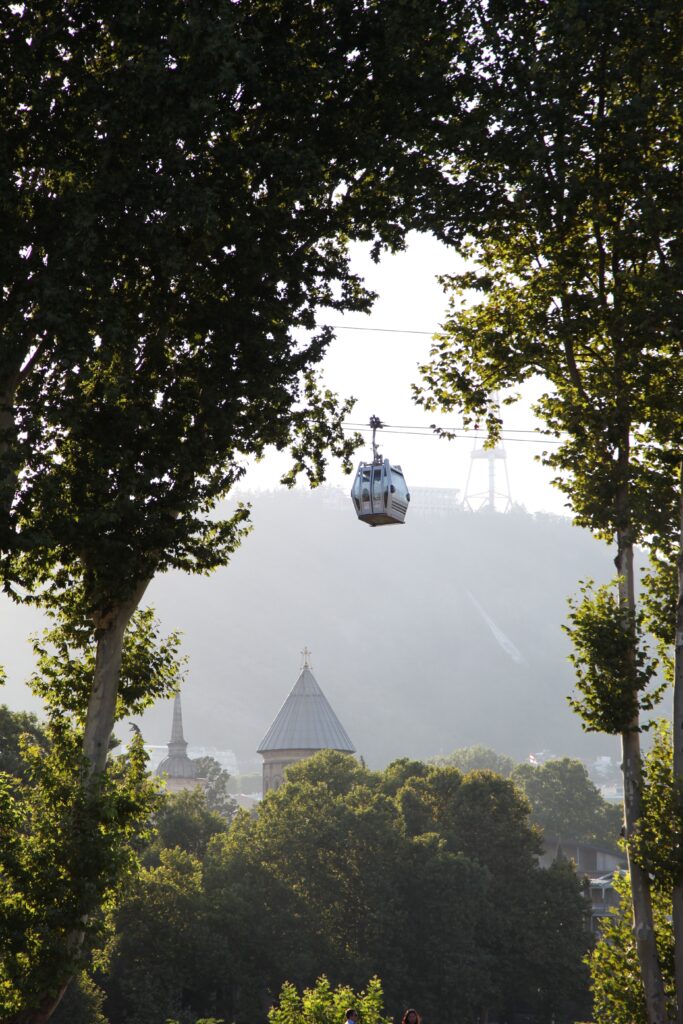
Famous Ropeway Locations in India
India boasts several stunning locations offering thrilling ropeway rides with breathtaking views. Here are some of the most popular spots:
Himalayan Region:
Gulmarg Gondola (Gulmarg, Jammu & Kashmir): This iconic gondola system takes you to Kongdori valley and further to Apharwath Peak, offering panoramic views of the Pir Panjal Range and the surrounding valleys.
Auli Ropeway (Auli, Uttarakhand): Enjoy stunning views of the Himalayas and the Nanda Devi peak from this scenic gondola ride, popular for skiing and snowboarding in winter.
Manali Solang Ropeway (Manali, Himachal Pradesh): This ropeway offers breathtaking views of the snow-capped mountains and lush valleys, ideal for a thrilling adventure.
Kullu Valley Ropeway (Kullu, Himachal Pradesh): Glide over the picturesque Kullu Valley and experience the grandeur of the Himalayas and the Beas River.
Western Ghats:
Skyview Patnitop (Patnitop, Jammu & Kashmir): The highest ropeway in India in terms of ground clearance, this system offers panoramic views of the Pir Panjal Range and the Chenab Valley.
Dhuandhar Ropeway (Jabalpur, Madhya Pradesh): Witness the cascading Dhuandhar Falls and the surrounding Narmada Valley from this scenic ropeway ride.
Karni Mata Ropeway (Udaipur, Rajasthan): Ascend to the Karni Mata Temple atop Machhala Magra hill, enjoying panoramic views of Lake Pichola and the City of Lakes.
Other Locations:
Darjeeling Ropeway (Darjeeling, West Bengal): This heritage ropeway, operational since 1968, offers breathtaking views of the Himalayas and the Darjeeling town.
Gangtok Ropeway (Gangtok, Sikkim): Experience stunning views of the Kanchenjunga peak and the surrounding valleys from this scenic ropeway ride.
Malampuzha Ropeway (Palakkad, Kerala): This ropeway takes you to the top of the Malampuzha Dam, offering panoramic views of the surrounding hills and valleys.
Raigad Ropeway (Raigad, Maharashtra): Ascend to the historic Raigad Fort, the capital of Chhatrapati Shivaji Maharaj, and enjoy breathtaking views of the surrounding landscapes.
Matheran Toy Train and Ropeway (Matheran, Maharashtra): This unique combination of a toy train and a ropeway offers a picturesque journey through the Matheran hills.
Factors to Consider:
Location and scenery: Choose a location that offers breathtaking views and aligns with your interests, such as mountains, valleys, or coastal landscapes.
Activities and attractions: Consider if the ropeway is near other attractions or activities you want to experience.
Accessibility and budget: Research the accessibility of the location, ticket prices, and any additional costs involved.
Travel season: Choose a travel season that offers favorable weather conditions and optimal views.
Ropeway transport in India offers a unique and unforgettable experience. By researching your options and choosing the right location, you can enjoy a thrilling adventure with breathtaking views.
